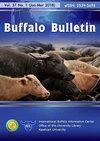Incidence and therapeutic management of Eimeria species infection in Murrah buffalo calves
IF 0.2
4区 农林科学
Q4 AGRICULTURE, DAIRY & ANIMAL SCIENCE
引用次数: 0
Abstract
The present study was undertaken to examine the incidence of Eimeria species infection in Murrah buffalo calves and evaluate the therapeutic management of the disease. In November 2019, 9 to 10 buffaloes calves up to 3 months of age showed symptoms of diarrhoea, loss of appetite, and poor weight gain at an organised dairy farm. Based on history, faecal samples were collected from 20 buffaloes calves and subjected to standard qualitative coprological examination and quantitative analysis using a modified McMaster technique. Out of 20 faecal samples, 90% were positive for coccidia oocysts. Among positive samples, 11% were heavily infected and 16% had a moderate level of infection of Eimeria spp. Six species of Eimeria were identified, E. bareillyi was the most often encountered species, accounting for 37.39%, followed by E. bovis (22.76%), E. zuernii (14.63%), E. ellipsoidalis (13.82%), E. canadensis (13.82%), and E. cylindrica (6.50%). Blood examination of mild and severely affected calves revealed a decrease in the mean values of hemoglobulin, total erythrocyte count, total leucocyte count, platelets and an increase in monocytes as compared with healthy calves. The affected calves were treated with combination of Sulphadiazine and Trimethoprim (Biotrim IV injection) along with supportive treatment for five successive days. All the affected animals responded well to the treatment and showed marked reduction in clinical symptoms as well as oocyst output.Murrah水牛幼崽艾美耳球虫感染的发生率和治疗管理
本研究旨在检测Murrah水牛幼崽感染艾美耳球虫的发生率,并评估该疾病的治疗方法。2019年11月,在一个有组织的奶牛场,9至10头3个月大的水牛幼崽出现腹泻、食欲不振和体重增加不良的症状。根据历史,从20头水牛幼崽身上采集粪便样本,并使用改良的麦克马斯特技术进行标准的定性粪学检查和定量分析。在20份粪便样本中,90%的球虫卵囊呈阳性。阳性样本中,11%为重度感染,16%为中度感染。共鉴定出6种艾美耳球虫,巴氏艾美耳球虫属是最常见的种类,占37.39%,其次是牛艾美耳球虫科(22.76%)、祖尔尼艾美耳球虫病(14.63%)、椭圆艾美耳球虫学(13.82%),轻度和重度感染小牛的血液检查显示,与健康小牛相比,血球蛋白、红细胞总数、白细胞总数、血小板的平均值降低,单核细胞增加。受影响的小牛连续五天接受磺胺嘧啶和甲氧苄啶(Biotrim IV注射液)的联合治疗以及支持性治疗。所有受影响的动物对治疗反应良好,临床症状和卵囊产量显著降低。
本文章由计算机程序翻译,如有差异,请以英文原文为准。
求助全文
约1分钟内获得全文
求助全文
来源期刊

Buffalo Bulletin
AGRICULTURE, DAIRY & ANIMAL SCIENCE-
CiteScore
0.50
自引率
0.00%
发文量
53
审稿时长
>12 weeks
期刊介绍:
Buffalo Bulletin is published quarterly in January-March, April-June, July-September and October-December. Contributions on any aspect of research or development, progress reports of projects and news on buffalo will be considered for publication in the bulletin.
 求助内容:
求助内容: 应助结果提醒方式:
应助结果提醒方式:


